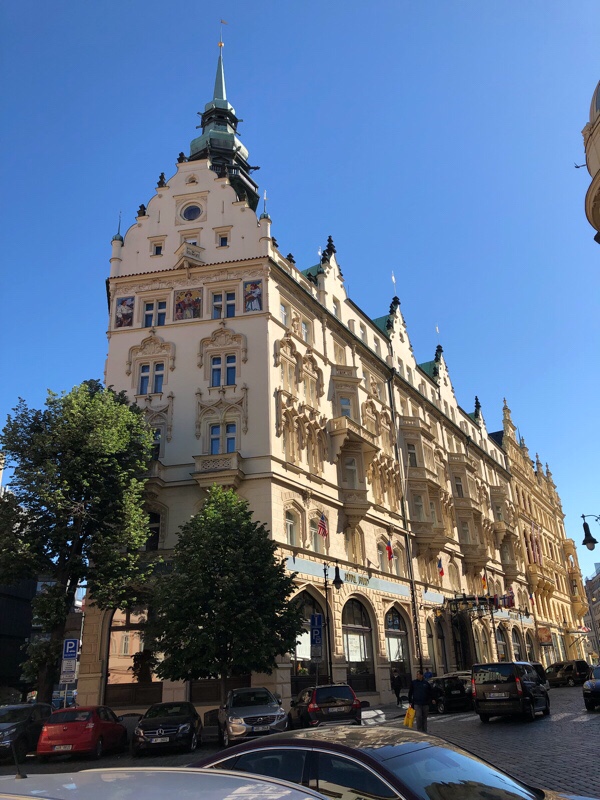
After wandering around in it for not-quite-two days, Prague seems a little…schizophrenic? I’m not sure what word I really want, there, but let me try and explain.
The city is all layers, in all directions: Art Nouveau swirls nestle in next to Baroque curlicues, Gothic arches tower over it all…and then, right across the cobbled streets, McDonald’s. Poetic gardens and somber, brooding synagogues…right alongside clusters of loud, tacky shops aimed at tourists and establishments offering Thai massages. Spotlessly clean facades, well-maintained for the upcoming centennial celebrations, and also ubiquitous graffiti.
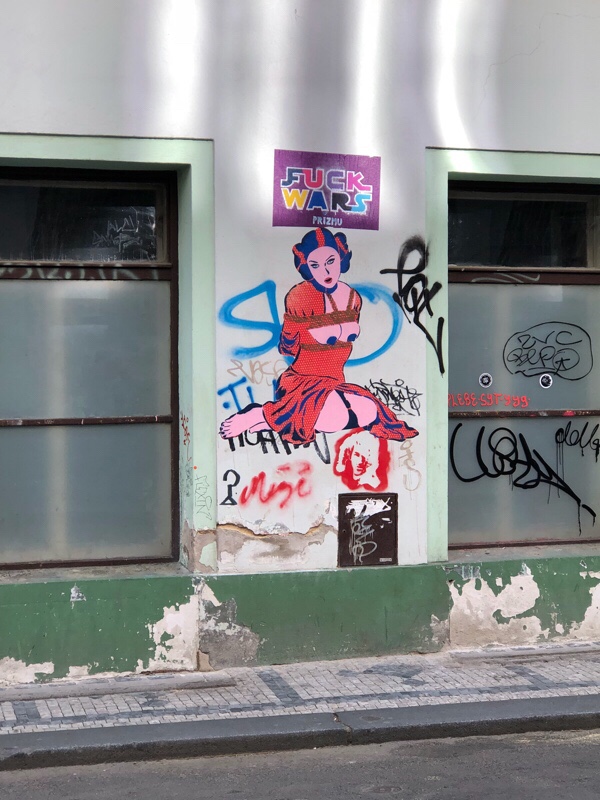
We opened our first full day here with breakfast at our hotel, then made our way to the Museum of Communism, a smallish but interesting exploration of the Czech Republic’s experiences with the philosophy and its proponents. In practice, it is a little bit more of a “Museum of Ways Communism Sucked” – if the descriptions of the exhibits and the little videos of personal stories are anything to go by, the Czechs suffered quite a lot under communism and were pretty damned happy to see the back of it. Take this thing, for example:
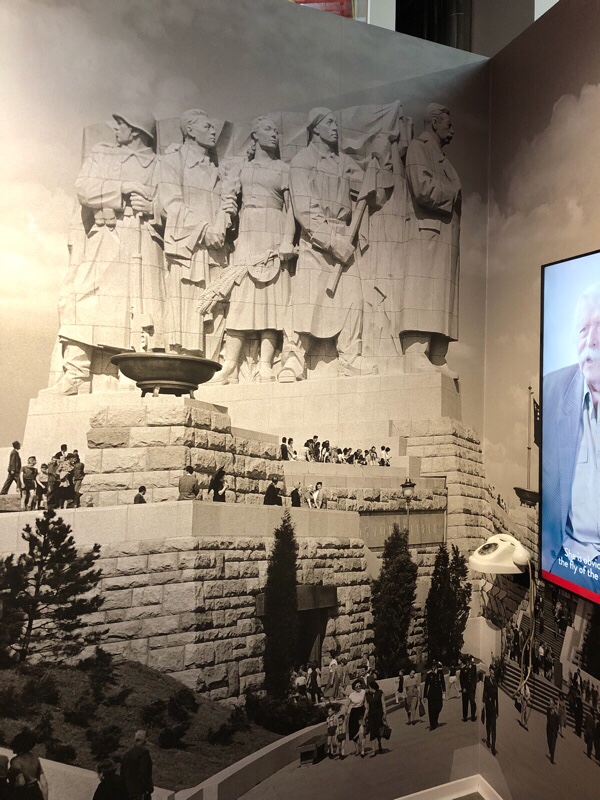
It took something like 7 years to build, acquired the nickname “the line for meat,” and when communism fell it was demolished so completely that nothing at all remains to be seen of it today.
Or take the example of the young students like Jan Palach, who were so infuriated at the return of communist control after what seemed like a veering toward a different way of life that they literally set themselves on fire.
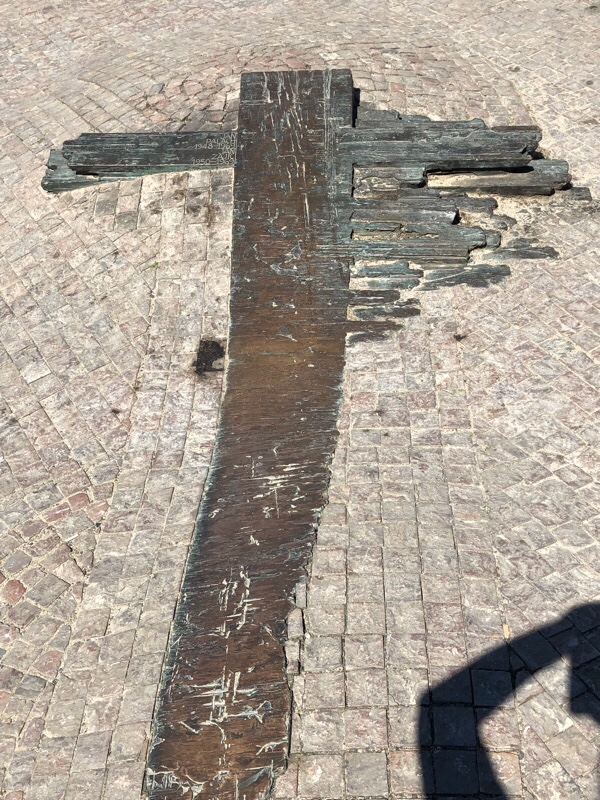
This cross is something we found later, commemorating their deaths in Wenceslas Square.
There is quite a “fuck this shit” societal attitude that seems to underpin much of the thought about religion and politics here, and it’s things like this that give you a sense why.
The museum also displays some interesting propaganda, and gives a handful of Czech folks the chance to tell their stories of repression, smuggling, becoming stateless to study in Austria, etc.

There’s also a lot of unsurprisingly-rather-cross descriptions of how much Russia was held up as the ideal to follow, some of which seemed full of more barely-concealed rage than I normally expect from museum text. The souvenir shop, by contrast, is all black humor: a “we can do it!” proletarian lady is shown on the side of a coffee mug, with the slogan “Solidarity from your communist sisters! Who would have burned their bras if there had been any in the shops.”
Stop number two for today was the Old Town Hall, where for some centuries the city has conducted its urban business.
Our guide was a pleasant, white-haired fellow who spoke a dizzying array of languages, and who explained to us that although a number of features of the building are off display for renovations (like the famous astrological clock, which has been covered by a screen that shows a video of the little show on the hour. Probably just as well; there would be a LOT of angry tourists otherwise) there’s still plenty to see.
By law, once upon a time city halls like this one had to include a chapel, a dungeon, and a kind of courtroom: this is true of the one in Prague as well. Sadly most of what was in the chapel was out for restoration work, though the glass was lovely:

The mayor’s ceremonial rooms contain a variety of original and reconstructed architectural detail, though right at the very end of the war of course some jerks lobbed grenades into it and destroyed lots of cool interior details, like the original bell from the tower. You can still see the original “suffering Jesus” from the 1300s, though:
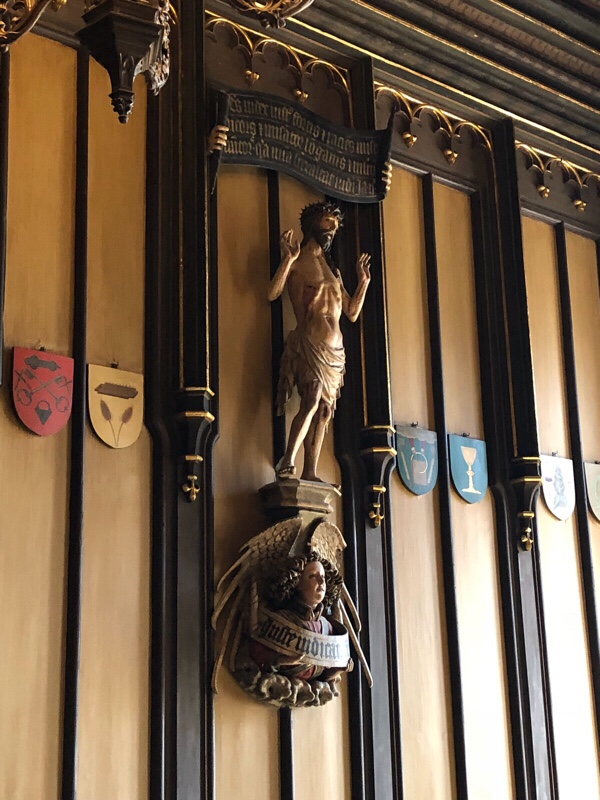
The mayoral chamber is also lined with crests. If one looks closely enough, they’re not heraldic representations of noble families though – they’re guild crests from the various occupations that kept the city running. A ship represents traders, crossed knives the butchers; hat-makers have a swirling starfish of ostrichlike feathers.

In a hallway just past this, a massive Sevres vase commemorates friendly relations between Prague and Paris:
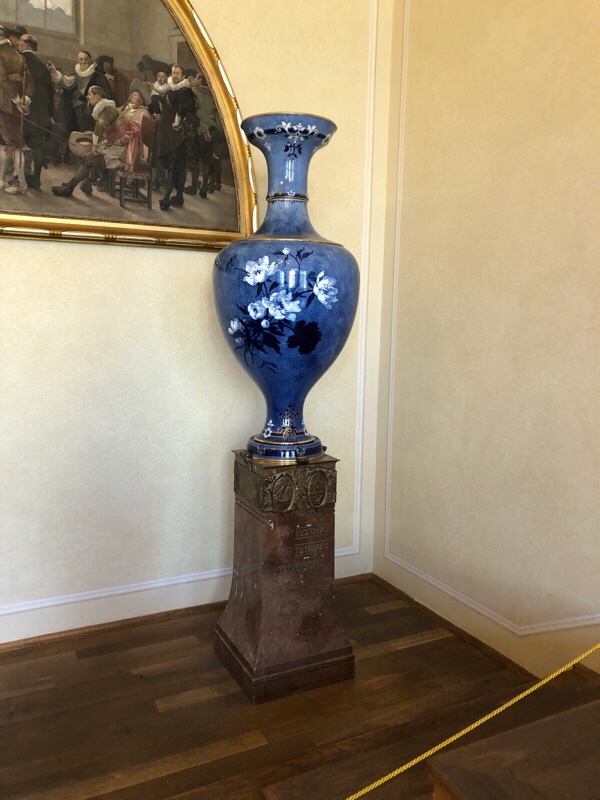
Grander halls for formal pronouncements and the like eventually give way to one of the many winding staircases we ended up seeing today. This one took us into the lower levels of the Old Town Hall, where that third essential was: the dungeon.
It looks a bit more like a cellar these days, to be honest, but once upon a time this was a place of some terror, I suppose – particularly the “Purgatory” cell where they would throw people without food, water or light, sometimes for days at a time.
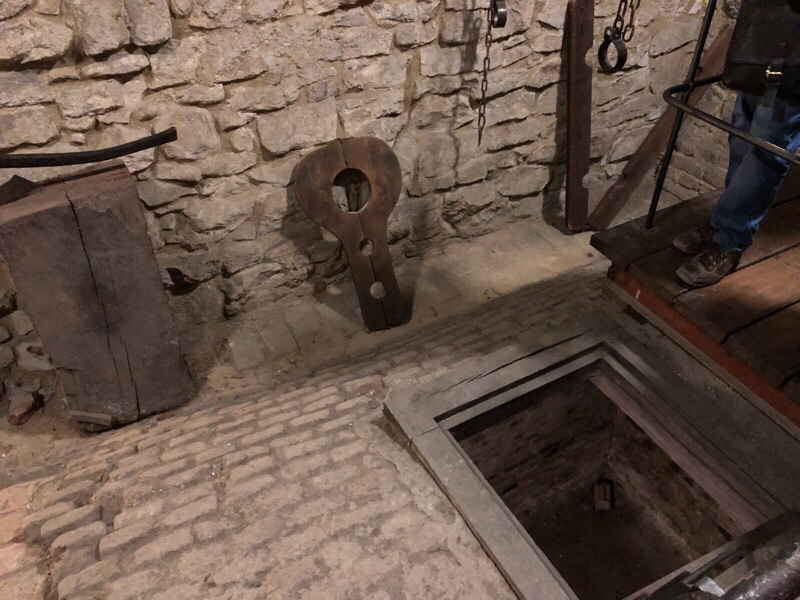
On our way out Mark casually happened to mention that he’d considered asking our guide about what it had been like under communism for him; I would have decked him for this, honestly, and told him so.
Here there followed an interlude wherein we attempted to locate a 3DS power supply, as we learned rather too late that North American power supplies won’t work with an adaptor. …Oops. We were unsuccessful, sadly, but had an interesting side trek out of the tourist areas and into a grittier area of the city. Looked a bit like the sketchier areas of Toronto, honestly, except the graffiti was unreadable and the streets were paved with approximately one gazillion stones about three inches square. (We had the opportunity to observe what I suppose are the Prague public works folk at work: a gang of fellows who were pretty obviously a road crew, hammering a number of these square stones into place to repair a broken pattern.)

We also stopped for a banh mi; it seems that Vietnamese folk are surprisingly common in Prague and the food is correspondingly so.
Next stop, the Municipal Hall. This is about the most boring name I can imagine for what Rick Steves calls “one of the best-preserved Art Nouveau interiors in Europe”; after having been there myself I can say that while I don’t know about the rest of Europe, it’s still a goddamn spectacular interior. Photography was, sadly, not allowed inside most of the building, so I’ll have to attach links or something to this later. (Later: Hey, here’s a virtual tour! Enjoy.)
I can still show you the outside, though:
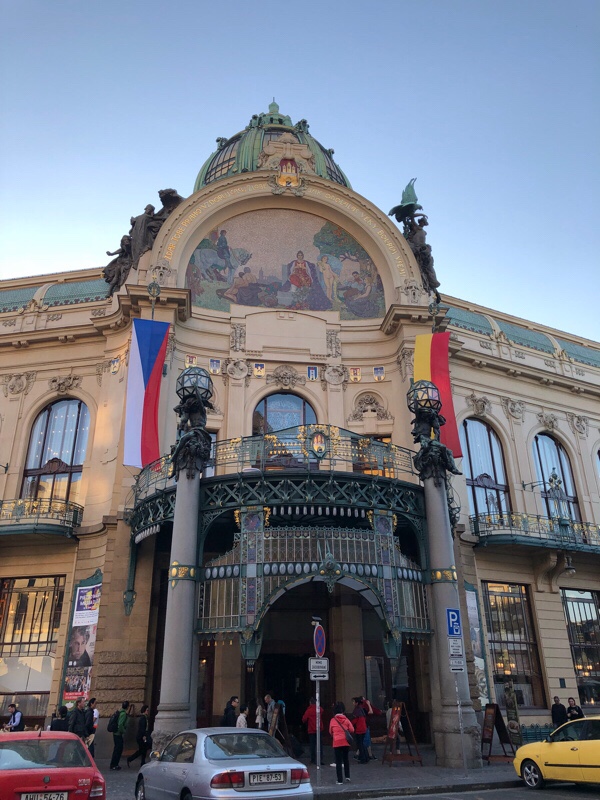
So what the heck is this place anyway? It’s…well, a series of rooms, mostly: an array of salons, dance halls, and smaller rooms laid out in a rough triangle around a huge and beautiful concert hall. The “municipal” part is taken quite seriously, too – all of the rooms may be rented by the public for meetings, social functions, etc. Mainly it sees use as a concert hall these days; every time we passed this place on the way around town there seemed to be something going on.
On one side of the triangle are the “ladies’ rooms“: chambers with dainty decor, full of rounded shapes. Each of the rooms in the Municipal Hall has a dominant motif – once you have identified this, you can see it everywhere. Medallions on the ceilings, metal grate covers, light fixtures, upholstery. One room dedicated to folk art themes even uses its dominant shape for a fish tank: little bronze snails serve as the tiny fountain heads that once kept it filled with water.
On the other side are the “gentlemen’s rooms”: more vertical lines and structured shapes, and artwork more in keeping with…well, a cross between Art Nouveau allegory and van art: one room had huge and dynamic allegorical paintings of love, war and the death along one wall.
By far the most dramatic room, though, is at the point of the triangle: a round-ish room decorated entirely by one Alfons Mucha. It’s not all that large a space but even so it is spectacular: a reflection of his faith in the power of the Slavic folk if they but worked together, with the slogan “Through strength, freedom; through love, concord” in bright silver over one of the doors. From panels below the ceiling characters from Slavic folklore glower, smile enigmatically, or gaze into some point in the far distance; behind each a chosen saint or allegorical figure brandishes a symbol of theirs, also picked out in silver. In the dome overhead a falcon soars, surrounded by the figures of various folk in Slavic costume.
Mucha was apparently quite into Freemasonry, and the room is also apparently packed with hidden symbolism. I wasn’t equipped to identify all of those myself, but the room certainly does have an intensely mystical feel. Elaborate Art Nouveau drapes are stitched with aluminum thread, making them sparkly and doubtless more mysterious as well. (All that silver in the decor? Also aluminum.)
It’s a beautiful room, and I feel very sorry not to be able to take photographs to show you, but at least the tour hopefully has the hook-up for you (I cannot preview it on this device, sadly.)
The other important thing about the Mucha room is that it opens onto a balcony. There, some historic speeches have taken place; peering out through the glass doors it really feels like stepping onto a brightly lit stage. I can imagine how it must have looked with hundreds of people packed into the square below.
In the basement level of the Municipal House is a “Pilsner restaurant” and also the “American Bar”: we didn’t have time to stop at either, but I did get a snapshot or two, since they were allowed in the basement. 

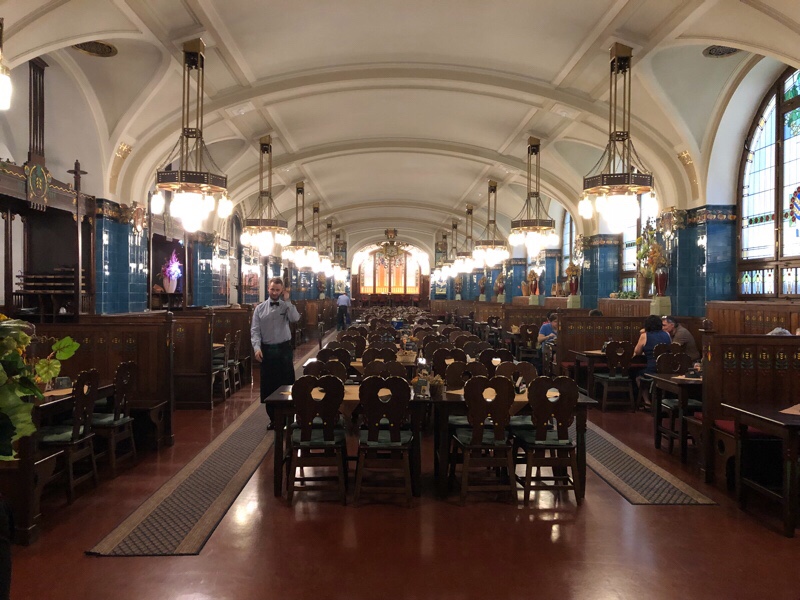
Our afternoon plan was to tour the Jewish Quarter. This is where Prague’s many, many Jews once had to live and work and is also home to the “Jewish museum in Prague,” a selection of synagogues that have been turned into exhibits on Jewish life, culture, and customs.
Some of the synagogues might be worth seeing just out of architectural interest – the Spanish synagogue, for instance, likely the most opulent of them:
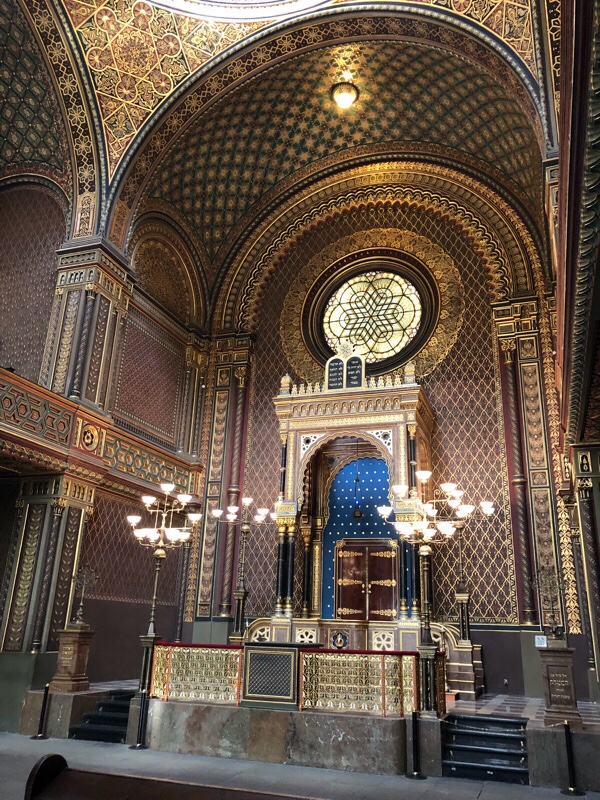
Here we learned about the period of Jewish life between the World Wars, a time when it seemed for a while there like Jews might gain real social acceptance in this part of the world. …Unfortunately we all know that didn’t exactly go as hoped.
(Unrelated but fun: This cool Kafka statue is outside it.)
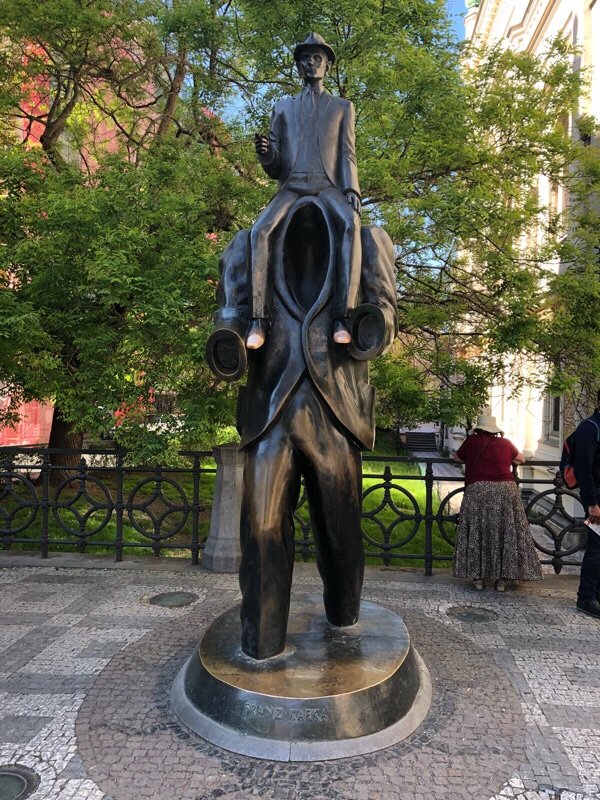
Indeed, at the next stop, the Maisel synagogue, we learned that apparently Hitler once planned to preserve the place as a museum of the extinct Jewish people. Ouch.
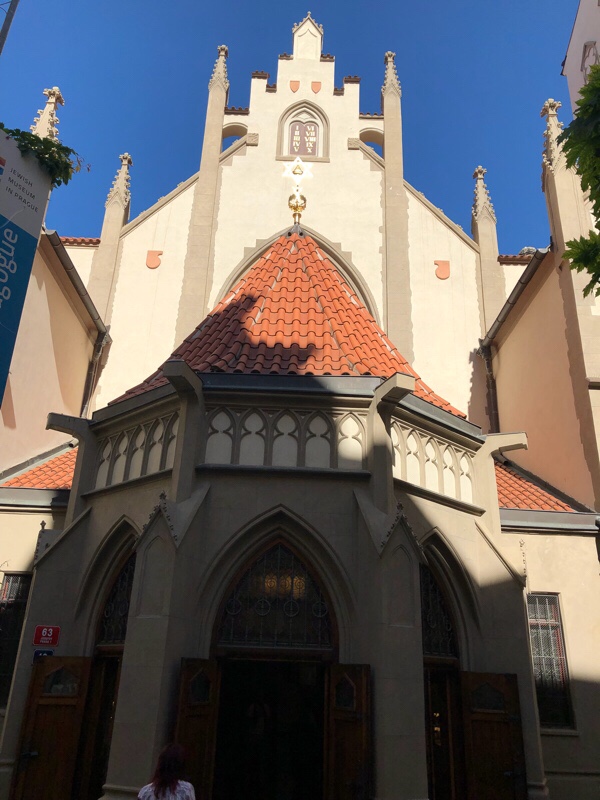
It has indeed become a museum, but instead it’s of the Jews of early Prague. Here I learned, for instance, that it seems Jews had been directed to mark themselves in some distinctive manner with a yellow somethingorother long before the yellow Star of David we’ve all seen in film and history books. (Once it was a distinctive yellow hat.)
We also were reminded that Prague is where the legend of the Golem that inspired the movie, etc, took place…and has been providing fodder for souvenirs of Prague for a good long time:
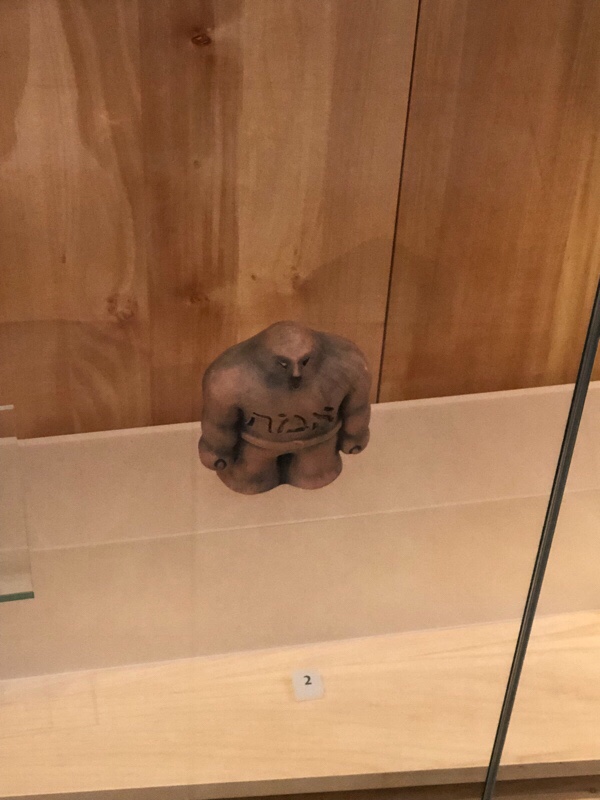
(One of the little shops outside a later synagogue even sold cinnamon-caramel Golem cookies.)
Perhaps the most dramatic point in our visit there, however, was the Pinkas synagogue. This is a relatively simple synagogue outside, but inside the entire interior has been first painted white and then inscribed with thousands on thousands of names birth dates, and dates of death if known: Czech Jews, most of whom were transported to Terezin and then killed.
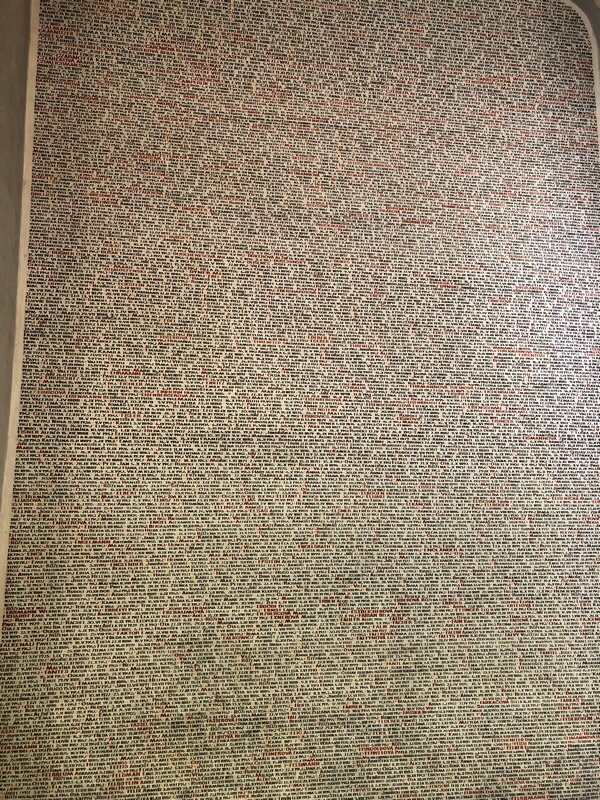
Upstairs, a small but deeply heartbreaking little exhibition of children’s drawings from the Terezin camp: some 8000 kids were sent out there, but of that number only something like 250 survived. Some drawings are of the sort one sees at kitchen tables everywhere: horses and street scenes and the like. Some are incongruous: a rainbow arcing over a green field…in which armed soldiers herd deportees toward a train with their tiny suitcases in hand. Some are, frankly, rather hard to look at: shadowy half-formed creatures with names like “Fear” and “Darkness,” a vast table lined with empty chairs and a single child-sized figure looking on.
I…didn’t have the heart to take photographs in there, honestly; sorry, guys.
Outside is the Jewish cemetery, which was for centuries the only place in town where Jews could bury their dead. There are about 12,000 gravestones here, densely packed and at all angles like jagged teeth; take that number and just about quadruple it, though, and you’ve got something closer to the number of bodies actually buried here. Pebbles and small prayers are placed on the headstones of some notable folk, though as weathered as some of the stones are I’m not sure how one would know who was who.
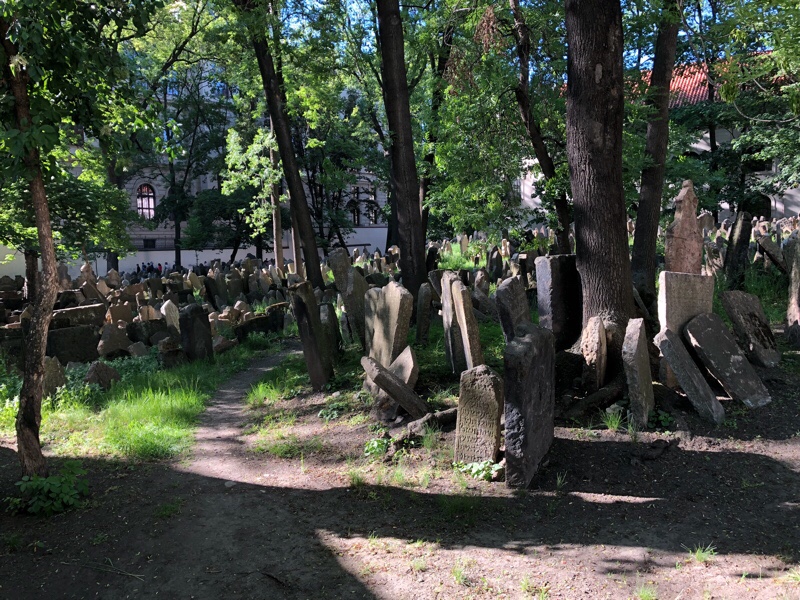
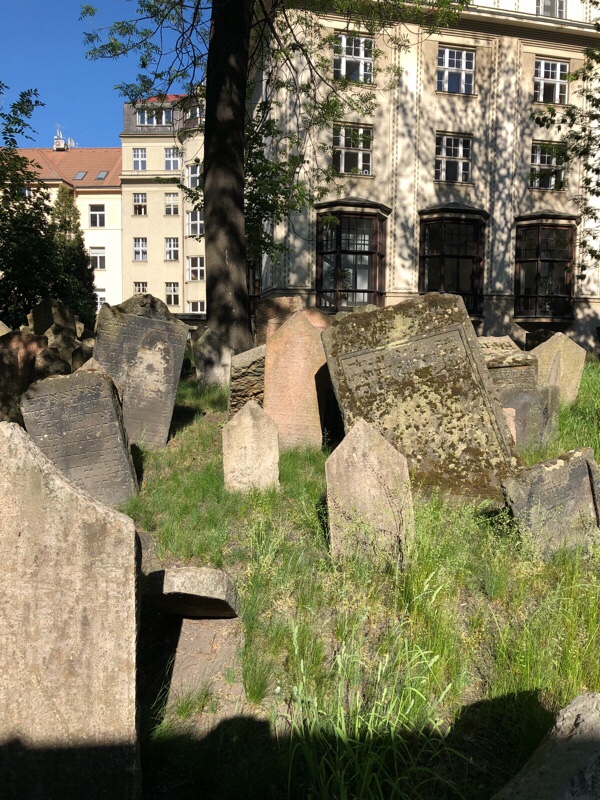
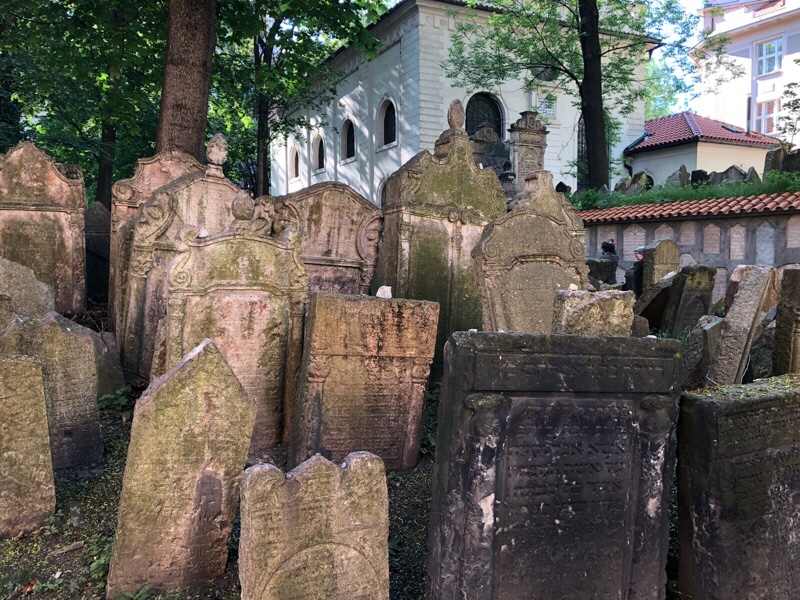
The adjacent Klausen synagogue and its Ceremonial Hall house exhibits on Jewish customs (circumcision, marriage, etc) and death rites. I hadn’t heard before about the existence of “funeral societies” – groups of folk who ensure that the dead are buried with all appropriate rites and that nobody who is without relations is left without someone to care for them – but apparently they were a big deal. (They also held dinners, like social/service organizations I’ve seen back home. Sort of like a funeral-focused Rotary Club, I suppose?)
Our next stop was one of the local “ghost tours” – a bit cheesy perhaps, but this one actually turned out to be fairly charming. Our guide was a young French girl named Maelane who’s apparently been living in the city for about four years for school and was reluctant to go back; her obvious enthusiasm for the city was rather charming.
Things we heard about include:
- The story of a young girl who was killed by a fiery chariot drawn by goats. This supposedly appears from time to time on the street outside what was found in 2002 to have been an alchemist’s laboratory. Poisonous gas and accompanying hallucinations for the onlookers, perhaps?
- The tale of “The House of Death” – home to a young woman who may possibly hold the record for worst luck ever. Her infant son was kidnapped, her husband died of heartbreak, and she then found happiness again with a traveling artist many years her junior (no points for guessing that this guy does indeed turn out to be the long lost son.) As incest was a capital crime, her son was then executed while she watched, and she went on to hang about mournfully gazing out of her window until one day she wasn’t there any longer. Concerned locals going to look for her found that she had died of the Black Plague, just for good measure.
- A haunted hospital, because you’ve gotta have one of those.
- The story of a young girl whose father refused to let her marry the love of her life, a penniless knight. Dad chucked her into the convent of St. Agnes, but soon found that her lover had an irritating habit of turning up to climb over the wall for visits. Sword fighting ensued, and when the girl tried to intercede, her father killed them both in rage. Today the ghost of the young girl appears to couples in trouble. (Happy to report that we didn’t see her.)
- The story of twelve nobles who were beheaded and had their heads put on pikes after the Prague Defenestration (that is, the time when some angry folk chucked some of the local leadership out a castle window by way of making their point. Unfortunately for them, the individuals survived, reportedly by landing in a giant pile of horseshit, and…well, executions ensued. The heads hung on pikes, in little cages, for many years, and supposedly their previous owners still have protective feelings toward their homeland. Every year on the summer solstice, they rise from their graves and make for the old town square, where they await the striking of the astrological clock. If it fails in any way, this will be a sign that dark times are coming for the country, and the ghosts will linger until they are confident that all is well. This does certainly raise some questions given that the clock will still be getting restored round about that time this year.
- The story of the original clockmaker, who supposedly had his eyes put out after building it so that he would not be able to make anything so impressive for another city. Feeling understandably vengeful, he first cursed the clock so that anyone who made alterations to it would go mad or die before having an apprentice remove a key piece so that the clock failed to work afterward. Later, a local painter who wasn’t afraid of no ghost was hired to restore the astrological dial and made modifications to it. This didn’t seem to go well, as apparently he began losing his mind shortly thereafter, and his ghost supposedly wanders the district he most loved in the city.
- The story of a wealthy local woman with a tendency to mistreat her servants who killed one in a fury when she stopped to pray at the sound of the church bells outside. The serving girl then haunted the woman until she eventually donated all her money to the church and moved into a convent herself.
- We also heard at least one sad story from the more mundane world. A friend of our guide’s apparently lost her brother to the secret police when her dad tried to go west, planning to bring them with him. They never heard from their father, but both the mother and brother were taken in for questioning, and the brother died. Much later, after the Berlin Wall had fallen and records began to be unsealed, they learned that Dad had in fact written letters, dozens of them, at least one almost every week for years and years until at last he reasoned they must be dead. The family was quite surprised to learn he was still alive.
Here ‘s our guide, by the way:
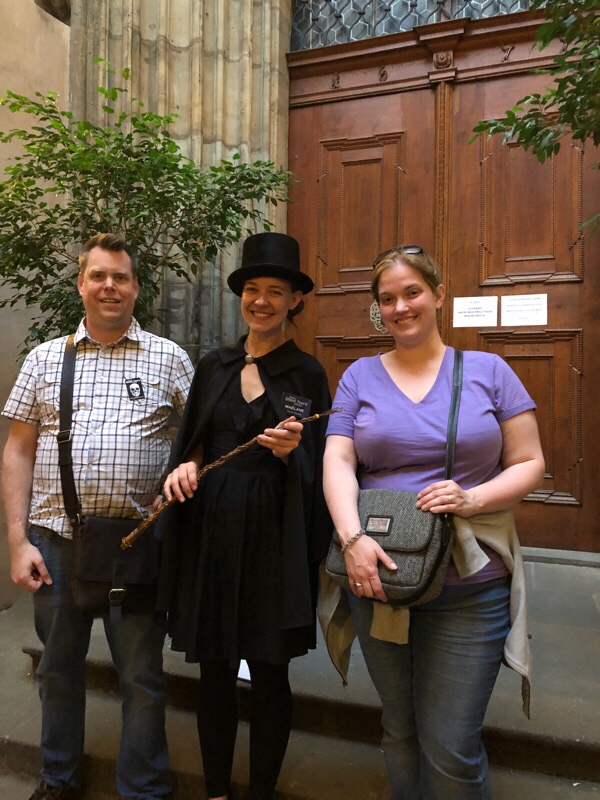
After this it was after 8 pm local time, we set out to look for a dinner spot in our “taste of Prague” book; half out of curiosity and half out of convenience we ended up at what is apparently the only Mexican restaurant worth one’s while in the city.
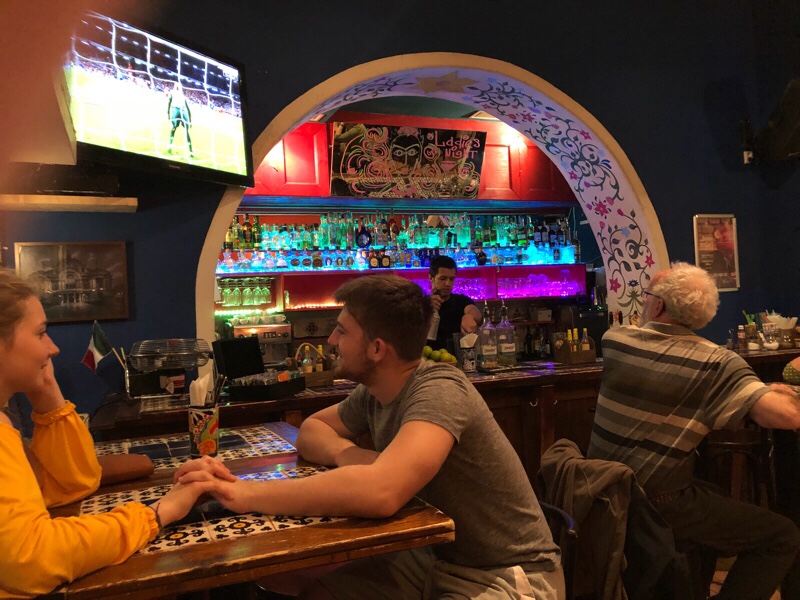
I was impressed to see horchata on the menu; I almost never see that even in Canada – but all became clear when we fell to chatting with the waiter. Apparently the place is owned and run by Mexicans, and they feel that Prague is treating them well.
Our final stop for the evening (as it was after 10 PM at this point) was also from the Taste of Prague book: “Anonymous Shrink’s Office,” a local speakeasy bar.

You might think that’s the door, but it isn’t.
We had the place pretty much to ourselves, and chatted with the bartender, who presented us a series of Rorschach-like picture cards, each of which corresponded to a signature drink.
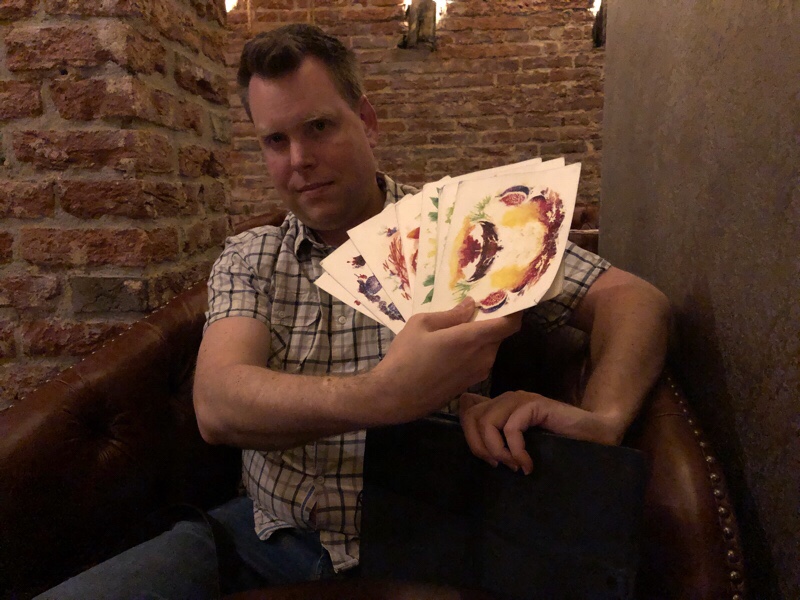
I selected something rather like a butterfly in rather lurid shades of red and purple, and ended up with a Manhattan-like beverage garnished with a slice of dried apple and something like a dried cherry; Mark selected something that suggested both plaid and Rorschach from Watchmen, and was served something that came in a flask filled to the brim with something white and smoky layered over the drink itself; the whole was poured over a massive block of ice in a rocks glass. It turned out to be a little more like an Old Fashioned.
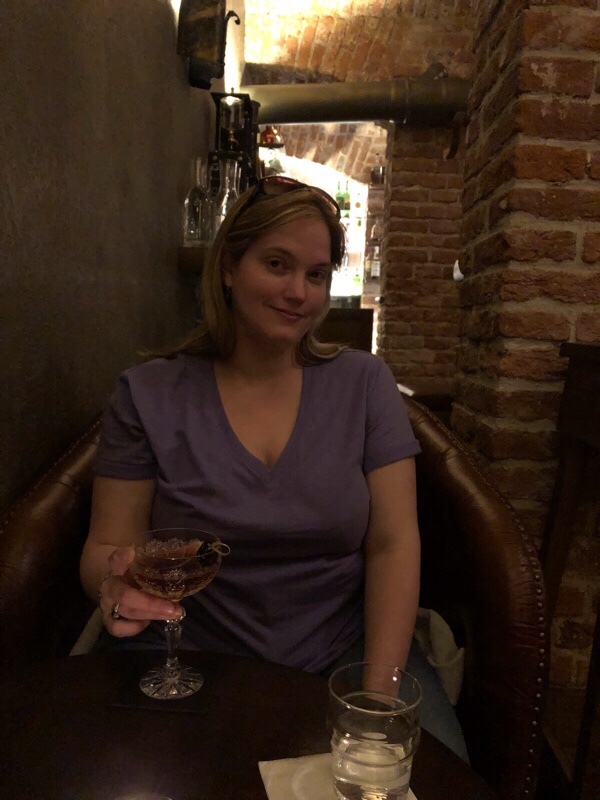
We followed this up with a hit of slivovitz for me (so I could say I’d tried it) and an absinthe for Mark. They serve the real stuff in Prague, though it is now prepared in such a way that one would have to consume a truly terrifying amount to get anywhere NEAR high. Still, it looks lovely with the accoutrements.
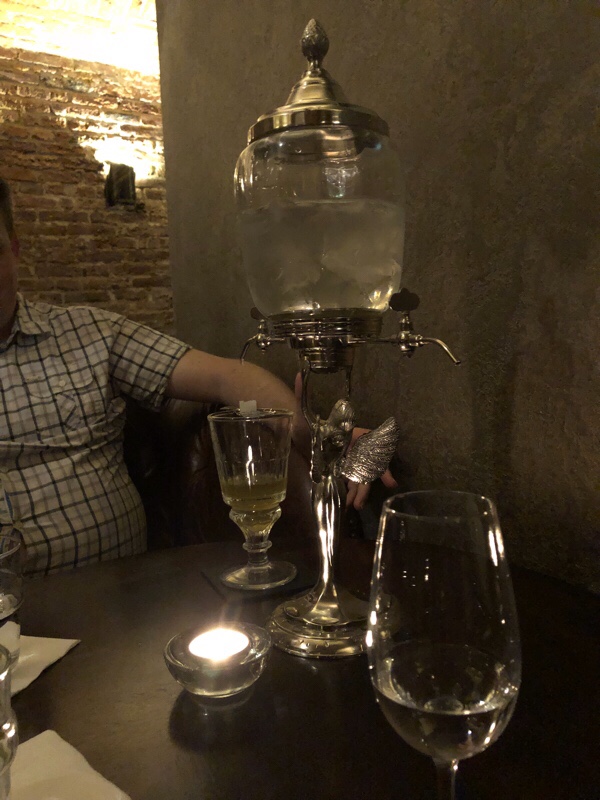
By now well and truly exhausted, we headed back to the hotel to crash. Mark figures we walked something like 25 to 30 kilometres today, what with all the back and forth…and my feet were certainly feeling it.
Oh well. Good night, Prague – that was one packed day.